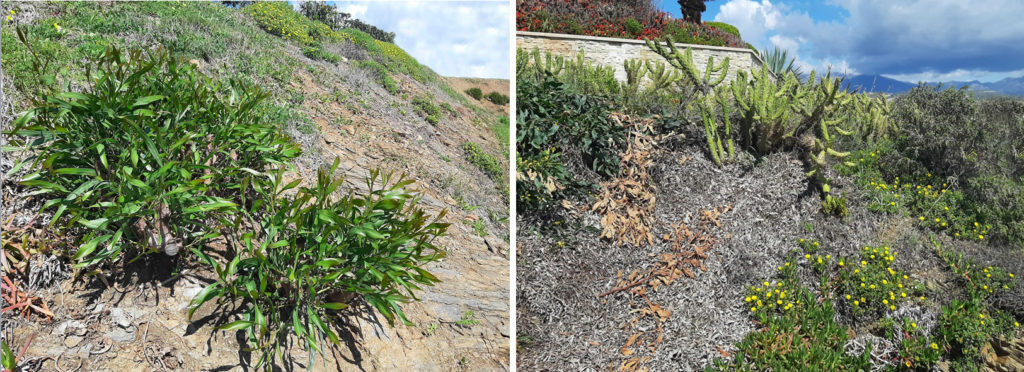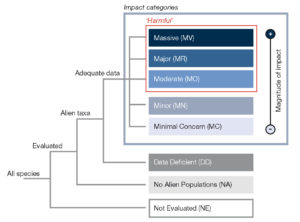Currently there is a tendency to revalue native or autochthonous species. But on this important topic 3 questions often arise:
- Given the great variety of available species, why should we choose only native plants?
- What problems are created by the introduction of exotic species?
- Why should the conservation and recovery of native forests, thickets and savannahs be promoted?
There are multiple reasons:
Because, currently, the main threats to ecosystems at a global level are the direct destruction of native species by the action of humans and by the arrival of invasive introduced species. (Rapoport, 1979; Cronk & Fuller, 1995; Rubec & Lee, 1997; etc).
Because the expansion of these species often escapes human control, producing what is known as biological invasions. It is a process that begins when certain organisms are intentionally or accidentally taken by man from their natural habitats to new territories, where many of these organisms adapt, reproduce en masse and become invaders. Invasive species have devastating effects on natural ecosystems, causing the decline and even extinction of native species, the destruction of the natural ecosystem and sometimes the complete alteration of the landscape. (Angassa 2005; Pejchar & Mooney 2009; Vilà et al. 2010; Eldrige et al. 2011).
Invasive species reproduce well and fast, competing with native species for habitat, soil, water, and food. In the case of fauna, they often devour native species. In the case of flora, they negatively affect the availability and quality of water and soil nutrients, they sometimes cover completely the soil or the surface of rivers and lakes, if they are elevated, make dense and permanent shade on the soil, eliminating heliophilous species and altering edaphic processes. In short, they have a very negative impact on natural biodiversity and ecosystem services (such as pastures, agriculture, livestock and fisheries) which ultimately also has an impact on human well-being. (e.g McDonall et al. 1989, Cronk & Fuller, 1995; Richardson et al. 2000, 2011; Pauchard et al. 2004; Jeschke et al. 2014).
It is already well demonstrated that ecosystems dominated by exotic species are not sustainable in the long term (Rapoport, 1975; McDonall & Cooper, 1995). The decline and extinction of native species due to biological invasions, depending on the cases, may be due to one or more mechanisms acting together, such as predation, parasitism, the transmission of new diseases, competition for resources, genetic contamination, hybridization, etc. (Díaz et al., 1998; Romero-Alcaraz & Ávila, 2000; Clavero & García-Berthou 2005; Downey & Richardson 2016).
The problem of biological invasions is of a dramatic magnitude and, to make matters worse, it is practically ignored or, in any case, underrated. The worst problem is not knowing that there is a problem. And for this reason, many times the extinction of a species occurs silently, without it being noticed (Guijarro, 2001). This must be taken into account immediately in all conservation policies (Dana et al., 2003).
Forecasts indicate that, if urgent and far-reaching measures are not taken, biological invasions will become more frequent and dangerous every day, also increasing the number of species that will continue to be introduced into new habitats (Essl 2011; Essl et al. 2011; Rouget et al. 2016Bellard et al. 2016; Johnson et al. 2017; Seebens et al. 2017).

The species of native plants also sustain multiple species of native fauna, which makes the conservation of these plants crucially important for the entire ecosystem. Jesús Charco.
But despite the fact that this serious environmental problem has been well known for decades, exotic plants are still prevalent in commercial and forestry nurseries. And worst of all, seeds of species from any part of the world can be found on the internet for sale without any type of control. Thousands of exotic and / or invasive species continue to be planted around the world for forestry, agronomic or ornamental purposes.
An added environmental and moral problem is that more and more people and institutions around the world, with good intentions but with little information, are frequently using alien species to supposedly help reforest the planet. Planting trees is now fashionable but, if they are not native species, many times it results in more damage than benefit for the environment.
Thus, in North Africa, introduced species from sub-Saharan Africa, Europe, America, Asia and Oceania have been detected. Pines, cypress, eucalyptus, agaves, prickly pears, plane tress, catalpas, acacias, locust trees and other species have been used here for decades, in the countryside, villages and towns, and some of them have a strongly invasive nature.
Many landscapes have a physiognomy that makes them look pretty to the inexperienced eye, even though they contain very little native flora and fauna. These are landscapes, often covered in trees, formed even by large plantations, lacking ecological value, silent, in which much of the local biodiversity have been lost, not resulting, however, in any substantial economic improvement. Forest or agricultural management is not the only cause, we are all responsible, since we do not normally choose native plant species for our cities, towns or gardens.
The problem is real and it must be faced. Now is the moment to unite our efforts to strengthen the knowledge and the use of native species, on one hand, and to eradicate exotic and/or invasive species on the other hand. Technical and economic means can and should be allocated to solve this problem but, undoubtedly, the main tool to fight this ever-growing ecological and socioeconomic problem is to raise the environmental awareness of society.
Schools should teach children to plant native species and to fight exotic ones; that is, children must learn to value and preserve the native plants of their region, its ancestral natural and cultural heritage.
The European Council released, in 2004, the “European Strategy for Invasive Alien Species”. The invasion of alien species is so severe that, since the beginning of the 80s in the XX century, the European Council has been urging its member countries to ban the introduction of non-native species in the environment, to establish prevemptive measures and to implement programs for their eradication.

Acacia saligna, Cilindropuntia imbricata y Carpobrotus edulis, 3 of the world’s most harmful invasive species grow together here. Their eradication is very difficult and expensive because after they are cut and / or uprooted, like eucalyptus and many other invasive species, they sprout again and again. Jesús Charco.
The scientific service of the European Commission, the Joint Research Centre (JRC) launched, in the summer of 2012, the European Alien Species Information Network (EASIN), with the goal of unifying the information and coordinating the fight against exotic species currently known in Europe (between 12,000-16,000 species, according to different studies). This confirms the serious threat that the exotic and invasive species represent to the biodiversity and natural resources which, on top of the ecological impact, has an economic impact estimated in 9,000 million euro per year. The European Commission has established the fight against exotic invasive species as a goal for the European Strategy for 2030.
In some Mediterranean countries, like Spain, laws such as the Conservation of Natural Spaces and of Native Flora and Fauna, Law 4/1989, determines that public administrations should stop the proliferation of alien species. Equally, in terms of official programs, the Spanish Strategy for the Conservation and Sustainable Use of Biological Diversity (1999) includes several mentions of the need to establish pre-emptive measures of control and eradication of such species. The Royal Decree 630/2013 regulates the Spanish catalogue of exotic invasive species.
In Africa, the Global Invasive Species Program (GISP) is in place, coordinating and facilitating answers for the ever growing threat that these species represent. One of its more interesting publications is called Africa invaded (Matthews & Brand, 2004), a very significant name.
A very active organization against invasive species in Africa is the Centre for Agriculture and Biosciences International (CABI). Sponsored by the United Nations Environment Programme (UNEP), CABI published “Invasive Alien Plants and Their Management in Africa” (Boy & Witt, 2013), an interesting document that synthesises the project called Removing Barriers to Invasive Plant Management in Africa (RBIPMA), developed by four countries between 2005 and 2010. In 2014, CABI published an educational video about invasive plants, “The Green Invasion. Destroying Livelihoods in Africa”.
The ISSG Thematic assessment of Invasive Alien Species and their control.
IUCN Invasive Species Specialist Group (ISSG) completed a report to deliver an update on the policy responses, legislation and management measures to control and prevent the spread of invasive alien species. This report aimed at supporting the ‘Thematic assessment of Invasive Alien Species and their control’ of the Intergovernmental Science-Policy Platform on Biodiversity and Ecosystem Services (IPBES). It was prepared by the IUCN ISSG through Biodiversity Data Management with funding support from the French Ministry for Ecological Transition (MTE).
The report can be see here:
The IUCN Environmental Impact Classification of Alien Taxa (EICAT)
EICAT is a simple, objective and transparent method for classifying alien taxa in terms of the magnitude of their detrimental environmental impacts in recipient areas. Based on evidence on the impacts they have been causing on native taxa in their introduced range, alien taxa are classified into five impact categories.

The different EICAT categories and the relationship between them.
The complete document can be see here:
https://www.iucn.org/theme/species/our-work/invasive-species/eicat
The ISSG Global Register of Invasive Species (GRIIS)
This Register has been developed by the IUCN SSC Invasive Species Specialist Group (ISSG). It is an initiative supported by the Secretariat of the Convention on Biological Diversity (CBD), of the UN Environment Programme. It compiles annotated and verified country-wise inventories of introduced and invasive species. For the publication and updating of the lists of each country, the Global Biodiversity Information Facility (GBIF) website has been chosen. The lists of introduced and invasive species in the North African countries can be seen here:
The ISSG has also published a list with 100 of the World’s Worst Invasive Alien Species.
http://www.issg.org/publications.htm#worst100
See here more studies and references on biological invasions:

